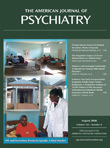When I received my copy of
Getting Old Without Getting Anxious, I was quite intrigued by the implications of the title. The lead author, Peter Rabins, M.D., is well known for
The 36-Hour Day (1), his classic companion for families of patients with dementia. To my surprise,
Getting Old Without Getting Anxious is not, as the title suggests, a volume of clinical wisdom about how to best survive the unavoidable insults of aging. Instead, it is a book about diagnosing, treating, and supporting older patients with anxiety disorders.
On the positive side, the book is chock full of valuable information, geared mostly toward children of seniors with anxiety disorders but useful for patients and anyone close to them. The coverage of topics is thorough and includes each anxiety disorder, its possible causes (biopsychosocial), appropriate differential diagnosis, various approaches to treatment, and possible difficulties along the way. While the book sticks to the medical model of disorders, it makes great effort to include perspectives of older adults (not unexpectedly, the lack of comfort with psychiatric diagnosis) and factors this into both treatment and support.
I take issue with more than a few of the book’s points that I feel don’t reflect its main objectives. For example, a model of categorical differences between illness and normative responses to events (as opposed to a multilayered stress-diathesis model) is probably an oversimplification of which Rabins is aware. The heuristic value of this dichotomy to patients and families outweighs such concerns, which can certainly be addressed with the individual clinician.
Overall, I have two main criticisms. First, the book is arranged in a boilerplate fashion, proceeding from topic to topic (at times repetitively), from disorder to disorder, and so forth. In this sense, it is more of a compendium than a support guide. Charts of symptoms are used throughout. Thoroughness is the word of the day, but it is at the expense of depth in many of the book’s sections. Moreover, treatments are usually given equal weight (is biofeedback with galvanic skin response really common treatment for phobias?). The author does address problems with unstructured group therapy and his preference for selective serotonin reuptake inhibitors and cognitive behavior therapy, but little else.
The explanation of cognitive therapy, which is so central to the book, sells cognitive behavior therapy a bit short and makes it sound like positive thinking. The distinction is particularly important here, since a common problem with treating axis I disorders among seniors is their notion that mental states are either amenable to will power alone or normal and unchangeable responses to events. Although mentioned several times, these reactions are usually attributed to some form of machismo rather than the cohort effect of growing up in the Great Depression and living through World War II. Positive thinking, a la Norman Vincent Peale, is a common obstacle to overcome in treating the members of this cohort and thus should be differentiated from cognitive behavior therapy.
My second bone of contention returns me to my initial sense of surprise upon surveying the book. One of the important tenets of geropsychiatry is that when a senior presents with new or worsening anxiety, a new anxiety disorder is rarely, if ever, the problem (posttraumatic stress disorder being the obvious exception). Depression, dementia, life adjustment issues, and medical problems are usually the causes of such symptoms. The authors glide over this important point by introducing histories of subclinical symptoms into case studies. A clear, overarching attempt to put anxiety symptoms in the elderly into perspective might have woven together many disparate threads.
In the end, there is much to be garnered from this book by an enthusiastic reader. I am not sure whether reading The 36-Hour Day or a book on a specific anxiety disorder would not be a better approach.

